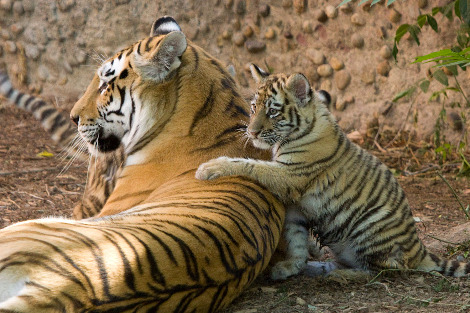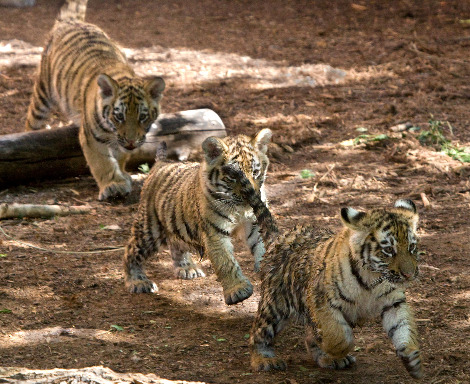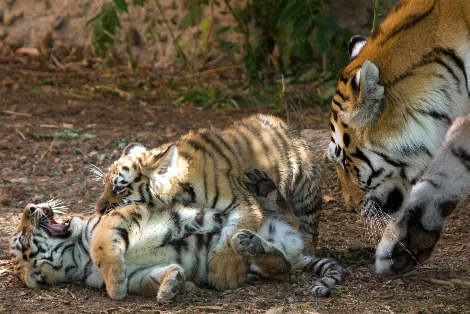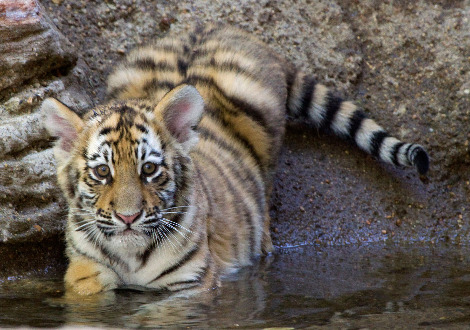For artists and collectors sponsored by Intercal...your mohair supplier and Johnna's Mohair Store





Look what we have at the Denver Zoo 








DENVER ZOO’S FOUR TIGER CUBS MEET THE OUTDOORSVisitors Can See the Quadruplet Tiger Cubs Now
Denver, CO (August 31, 2010) – Denver Zoo’s four endangered, Amur tiger cubs took a breath of fresh air Monday as they explored their outdoor habitat for the first time. The cubs – females Zaria and Akasha and males Nikolai and Thimbu – were each given a clean bill of health in their last exams and are ready to meet the public. The quadruplet cubs, born May 31, are the first of their species to be born at Denver Zoo since 2003. Just in time for Labor Day, visitors can see the foursome now at the Feline II Building. The best time to see them will be between 10 a.m. and 2 p.m.
The cubs were born to mother, Koshka (Koosh-kuh), and father, Waldemere (Wald-uh-meer). Waldemere was born at Denver Zoo in 2003, but Koshka was born at the Beardsley Zoo in Bridgeport, Connecticut in 2005 and came to Denver in late 2008. The two were paired under recommendation of the Association of Zoos and Aquariums (AZA) Species Survival Plan (SSP) which ensures healthy populations and genetic diversity among zoo animals. Fortunately, the couple has proved to be an excellent match.
Amur Tigers are seasonal breeders and in North America generally breed January through June. After a gestation period of approximately three months, two to four cubs are born in a sheltered den. They are nursed by their mother, who rarely leaves them. At about two weeks old their eyes open and their first teeth begin to erupt.
Amur tigers are classified as critically endangered, with an estimated population of less than 400 individuals remaining in the wild. These animals were once called Siberian tigers because they were found throughout Siberia. They are now almost completely confined to the Far East portion of Asia along the Amur River and because of this they are now commonly called Amur tigers. In addition to habitat loss, the biggest threats to these tigers comes from poaching, both for their fur and their other body parts which are used in traditional Chinese medicine.
Amur tigers are the largest member of the cat family. They can grow to nearly four-feet-tall and more than seven-feet-long. Koshka is smaller than Waldemere, weighing in at more than 280 pounds during her wellness exam, while Waldemere weighs an estimated 360 pounds. Amur tigers also have longer hair and more white on their coats than other tigers.
Oh, my goodness! What beautiful animals!
Becky

 What a beautiful thing to see and also so sad to know that these tigers as well as many other animals in the wild are on the critically endangered list and that there are very few people who care, not nice or good at all
What a beautiful thing to see and also so sad to know that these tigers as well as many other animals in the wild are on the critically endangered list and that there are very few people who care, not nice or good at all 
Very gorgeous felines! 




Magnificient creatures!
Wow, beautiful. I'd love to see them for real.
Hugs, Jane. 


Oh! I so much want to make one of these cubs! I'll get to work on it when I get back from Chantilly 
Karen
Aww, so cute. We have some Amur tigers and cubs up at a wildlife park in the Highlands. I saw them in the snow last winter, they were having so much fun playing in it!